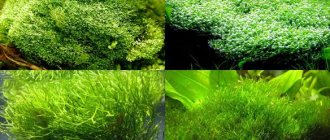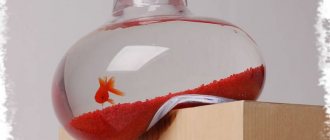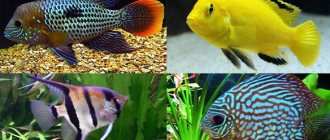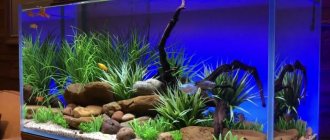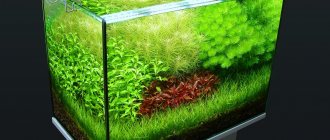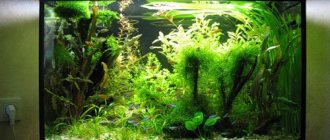Features of backlight placement: don’t leave it for last
The well-being of its inhabitants depends on how correctly the lighting is placed in the aquarium. They note that the disorderly installation of lamps will not allow fish to develop. In most cases, this is fraught with overheating of the water or insufficient glow, the death of plants that are important for enriching the aquatic environment with oxygen.
Most often, lighting is equipped with special stands or brackets. It is installed either on top or on the sides of the aquarium (primarily depends on the configuration). The most common type is to place the light bulb on the inside of the lid.
Location of single lighting for an aquarium in the upper part above the lid Source gidcen.ru
Regardless of the chosen location, the structures are supplemented with reflectors (mirrors, special plates). They allow light rays from the lamp to return to the water, providing good efficiency (efficiency) from the sources. There are location options - close to the water. However, this approach is not always appropriate. This is due to the fact that most light bulbs emit heat, and if the water overheats, its inhabitants will begin to die.
If such lighting options cannot be avoided, then filters and coolers are placed in the water, which will circulate the water in a constant mode. The lamps themselves are installed on a height above the aquarium. Usually they maintain a distance of -30 centimeters or more. For this purpose, special suspensions, stands, and adjustable brackets are designed.
It happens that the lighting intensity provided by the overhead light in the aquarium is insufficient. It is necessary to compensate for this phenomenon by additionally installing light bulbs: on the sides, if the aquarium is transparent, in the lower part (at the bottom). By and large, the latter option plays a decorative role. But, it is quite capable of solving the problem of the shortage of light rays.
On a note! If you need to add decorative light, then it is better to use spotlights that will be directed at some relief object in the house for aquatic animals.
Fluorescent lamps
In these devices, the bulb is filled with mercury vapor, which, under the influence of the electrical discharge occurring in the lamp, generates ultraviolet radiation. This radiation is converted into visible light by a phosphor substance deposited on the inner walls of the bulb, and different phosphors differ in the wavelength of the generated light, which determines its color.
It will also be useful for you to read the instructions on how to make an aquarium with your own hands and install the correct lighting in it.
Read here! Solar lamps: 110 photos of the best modern models for outdoor lighting
The advantage of such lamps is the high efficiency of converting consumed power into visible light compared to incandescent lamps. The disadvantage can be considered the need for a special power supply to convert the alternating current of the network into direct current of the required voltage.
Lighting power standards: understanding the parameters
There are plenty of generally accepted standards that aquarium lighting must comply with. We suggest you look into them and decide which type is more suitable for you.
- 0.1-0.3 W/l - such lamps are ideal exclusively for aquariums in which there is no living vegetation.
- 0.2-0.4 W/l - lighting sources with similar indicators are good for placement in an aquatic environment where mainly shade-loving fish live: catfish, nocturnal ones. With this lighting power, it is possible to grow aquatic plant crops: Java moss, cryptocorrines, echinodorus.
- 0.4-0.4 W/l - ideal for a home pond with a small number of plants. With such lighting power, plants will develop, but their growth will be slowed down due to lack of light and, accordingly, weak photosynthesis.
- 0.5-0.8 W/l - lamps of this kind are excellent for an aquatic environment, in which up to 90% of ornamental plants and a sufficient number of different fish are grown. With such source parameters, all crops will take on quite bright colors, and the fish housing itself will sparkle with bright colors.
- 0.8-1 W/l - suitable for an aquarium with a dense planting of algae. Lamps of this power are also suitable for cases where ground cover crops grow inside the reservoir. Aquariums with such filling are considered to be Dutch, Amanov.
One of the main conditions is to successfully select the power of the equipment and correctly adjust the direction of the glow. This will allow the fish to reproduce and receive oxygen normally. It is the number of watts in the lamp that is used when choosing aquatic pets.
Lighting an aquarium using an overhead LED light Source ukaps.org
Please note that in addition to the designation unit W/l, Lumens are also used. It is believed that this indicator is more accurate and it allows you to combine several characteristics that the lamp has.
On a note! If the illumination of the aquarium is not adjusted correctly, then even fertilizers and the artificial addition of carbon dioxide will not save the inhabitants. Soon all living organisms will wither away.
Using special lamps on aquarium stands Source aquariymist.4admins.ru
Multi-colored lighting for an aquarium using professional lamps Source ru.orphek.com
Lamps for luminaires
Modern production of aquarium lamps offers a huge selection of available models.
The following types of aquarium lamps are distinguished:
- Incandescent lamps designed specifically for aquatic environments are rarely used today due to the high heat generated by the glass bulb.
- Halogen lamps are also not often used because the lamps heat up the water very much. For sensitive fish species, such conditions can lead to death.
- Metal halide lamps are used to accelerate the growth of green mass in the aquatic ecosystem. Such models perfectly scatter the light beam, penetrating to a depth of 0.6 meters.
- Luminescent models are great for aquariums of various sizes. Today, this type of lamp is recognized as the most optimal for any type of aquarium.
- LED aquarium lights are widespread today due to their efficiency, beautiful design, and savings in use.
Among the latest lamp models, owners of aquatic ecosystems often have to choose contact or economical fluorescent lamps, which depends on the volume of the aquarium and the possibility of additionally installing a cooling cooler.
Types of lamps that can be used
Almost all lamps are suitable for lighting a home aquarium. Each of the lamps has both advantages and disadvantages. The following lamps vary in power and energy consumption. You can choose any of the options listed, the main thing is to create optimal conditions for the development of living beings.
- The incandescent lamp is a traditional light source that has been used for a long time. Its main disadvantage is the high degree of heating and high energy consumption. Actually, such a lamp provides little directional light. Also, the lamp is not able to prevent the development of pathogens, fungi, and water spoilage.
- Luminescent. This type of lighting in an aquarium is more suitable for unpretentious plants and animals. The equipment has low power, which indicates low energy consumption. Moreover, they shine dimly, no matter where you place them.
- MGL (metal halide). A very good option for a household aquarium. In appearance, the design is small-sized, has good brightness, and has a sufficient service life. The light emission is as close as possible to that of the sun, and accordingly, the aquatic inhabitants in the aquarium will feel many times better than with other aquarium lighting.
- LED. Suitable for most plant varieties and different types of aquatic pets. This type of lamp is characterized by a different type of glow. In terms of illumination, this is a fairly popular option, suitable for functional and decorative lighting of an aquarium. The downside is the high price.
LED spotlight for aquarium of standard sizes Source aliexpress.ru
Choosing lamps for aquarium lighting
After we have learned that light can harm life inside the aquarium, we move directly to organizing the correct lighting. First things first.
Main characteristics
This chapter will be entirely theoretical, but we advise you to remember everything well if you plan to implement such lighting in practice in the near future.
Aquarium light distribution table
Power - as with any electrical appliance, is measured in Watts. Here we present generally accepted standards when selecting a lamp.
- For 1 liter of clean aquarium water that does not contain live plants, use 0.1-0.1 W of lighting power.
- If there are shade-loving fish in the water, for example, catfish or nocturnal fish, then the previous value will have to be increased to 0.2-0.4 W per liter. It is possible that the aquarium will contain plants that do not require high light. These plants include: vallisneria, cryptocorynes, echinodorus (certain varieties), Java moss and others, the list of which you can continue by studying the topic on the Internet.
- If the aquarium contains a limited number of plants that love light, then the lighting power per liter can be increased to 0.4-0.5 W. However, despite the fact that the plants will develop, their growth will be quite slow, and they will also begin to lose their normal appearance, due to the fact that they will struggle to reach the light source.
Optimal lighting for aquarium plants
- If you need a beautiful decorative aquarium in which not only fish will feel comfortable, but also plants will grow, the illumination should be from 0.5 to 0.8 Watts per 1 liter of water. About 90% of aquarium plants will feel comfortable in such conditions.
- There are aquariums in which plants are arranged at a high density or contain ground cover species; they are also called Dutch or Aman aquariums. So, so that there is enough light in them, its power is increased to 0.8-1 W per liter.
To better understand the information, let's figure out what happens when light hits water. After penetrating into the thickness, its intensity begins to inexorably decrease - approximately, in water of average transparency, the brightness will decrease by 50% every 10 centimeters. Here is a diagram showing the intensity of the illumination drop.
Light distribution in water
As you can see, from the original 1937 Lux, after 50 centimeters only 60 and a half remained. For this simple reason, if you want to create a beautiful, vibrant aquarium with thriving flora and fauna, you need to go for the lower options.
However, measurement in Watts is not entirely correct, since, first of all, we are talking about the power consumption of the lamp itself, and if we remember that today different lamps produce different amounts of light per 1 Watt, then calculating the problem becomes almost impossible.
The opinion of Takashi Amano (Japanese photographer and aquarium designer who created the “Natural Aquarium” trend in aquarium art) and the ADA company (Aqua Desing Amano - founder, the same Takashi Amano) is very interesting on this matter. They moved away from the generally accepted measurement in Watts, believing that the illumination of the volume of water in the aquarium does not depend directly proportionally on this. As a result, some of its small models use 8 watts per liter, while larger ones use no more than two.
In the photo - Takashi Amano's aquarium
According to Takashi Amano, lighting should depend on the surface area of the water, since the total illumination is not only dependent on wattage, but also on many other factors, such as: the dimensions of the aquarium, the state of the water in it, the aging of the lamps used, power losses for heating the air and the cover glass , as well as much more.
Therefore, concluding the story about lighting power, let’s say that this parameter is the first on the list that you need to pay attention to. It is much more correct to measure the degree of illumination in Lumens. There are no clear recommendations on this matter, but there is one interesting table that collects some data from the ADA company.
Lamp luminosity data
The table is in English, but you don’t need to be a linguist to understand it - everything is extremely clear.
Types of light sources
Now let's name all the types of lamps that are used to illuminate water in an aquarium, making sure to mention their technical characteristics, as well as their pros and cons.
Incandescent lamps - classics are going out of fashion
- An incandescent lamp, or as it is otherwise called - “Ilyich’s” or “Edison’s” light bulb . It is based on a tungsten filament stretched between two cathodes, which begins to glow from incandescence when an electric current passes through it.
It was actively used for aquarium lighting in Soviet times, since, in fact, there was no alternative. Today, it is practically not used for such purposes, due to the high heating, power and high consumption of electrical energy.
However, every knowledgeable aquarist will tell you that these lamps have a luminescence spectrum as close as possible to that of the sun. Aquarium plants cannot help but like this feature. But the disadvantages still outweigh the only advantage.
In addition to the fact that the efficiency of the lamp is about 3-5% of the power consumption (the rest goes to heating) and a lamp of, say, 100 Watts has a low light output of 17.5 Lm, they need frequent sweeping due to their low service life. On average, this figure is 1000 hours.
Conclusion! It is disappointing - to properly illuminate an aquarium you will need quite a lot of lamps, which will produce a lot of heat that needs to be dissipated (fans are often used for this purpose, which make quite a loud noise). If the aquarium is not cooled, the water will begin to warm up, which will adversely affect its inhabitants.
Halogen lamp
- Halogen lamps are not much different from incandescent lamps, since, in fact, they are their direct heir, or more precisely the heir of the Yablochkov candle from the already distant 19th century.
Among the advantages, we can note the best efficiency - by 1 watt/28 Lumens. The declared service life is 4000 hours, which in practice is unattainable - they burn mercilessly.
You also need to be careful when installing, since the open flask should not be touched with unprotected hands. The fact is that its surface is covered with a special coating that reacts chemically with fats, so we install them only with gloves or using a cloth.
For aquariums, they are used as rarely as incandescent lamps, for obvious reasons.
Fluorescent lamps are one of the leaders for lighting aquariums
- Fluorescent lamps - we are gradually moving to the leaders of our hit parade. These lamps are among the most popular in the aquarium lighting industry.
And there are several reasons for this - a fairly reasonable price; long service life (up to 20,000 hours, subject to the balance of power supply and the number of on/off cycles); high energy efficiency (efficiency is 4-5 times higher than incandescent lamps).
However, they also have disadvantages - these light sources emit a reduced spectrum of light; the lamps do not exhaust their service life, because within a year, due to degradation of the phosphor, they lose their “useful” spectral characteristics; the light from them is scattered, unable to penetrate deep into the water effectively enough (the problem is eliminated by the use of reflectors and reflectors).
Not all fluorescent lamps are used for aquarium keeping. Let's highlight the following types: T8 - the most popular option due to the optimal combination of price and quality; T5 - these lamps are of better quality, but they are also more expensive, they emit brighter light with smaller dimensions.
Metal halide lamps
- Metal halide lamps are an excellent solution for an Aman-style aquarium or if your aquarium is deep (60 cm). These lamps are used by professional aquarists because:
Their prices are quite reasonable. They are capable of creating a powerful, directional light flux, the color temperature of which can vary from 2500K to 20000K. They last up to 15,000 hours and have excellent performance - about 100 lm per 1 watt.
There is only one drawback in our case - due to the large amount of heat generated, these lamps can only be installed on pendants or a stand at a minimum distance of 30 centimeters from the water.
Conclusion! Using metal halide lamps, you will get excellent color rendering. Your aquarium will shine like a Christmas tree, beautiful shadows will be visible and highlights will be created in the water at the bottom of the aquarium.
led lighting for aquarium
- Light-emitting diodes (LED) - despite the widespread use of such lamps in the domestic sphere, they are accepted differently among aquarists. The main reason for doubt is the lack of information about the practical application and the influence of some properties of LEDs that can harm the inhabitants of the aquarium, which have long been eliminated in normal products.
Without going into all the details, let’s say that today you can purchase very high-quality LED panels for aquarium lighting, which will have the necessary luminescence spectrum and will have an acceptable color temperature.
It is worth noting their undoubted advantage in energy efficiency and low electricity consumption. Almost all the heat generated by such lamps goes not with light radiation, but in the opposite direction - into the base, which is why such panels can be used under an aquarium lid without fear of overheating the water.
The visual effect, due to the very low dispersion angle of light radiation, is not much different from metal halide lamps.
LED lamps above the aquarium
Let's not forget about the shortcomings, of which there are not many:
- The cost of a high-quality LED spotlight is not comparable with the rest of the participants in this list, however, it is worth noting the trend towards lower prices recently, which is good news;
- Household LED lamps can only be used as additional lighting (can be used at night);
- If you are planning to illuminate your aquarium with LED strips, then we will disappoint you - you can only use powerful, expensive options.
In general, if you are still concerned about the use of LEDs for lighting, then we advise you to read the forums where aquarium enthusiasts share their experiences.
Lamp from ADA using fluorescent and metal halide lamps
Let us briefly summarize the research into lighting devices. The best solution today is the use of metal halide lamps, as well as their mixing with fluorescent lamps.
So, Amano’s principle is to illuminate the aquarium for 3 hours with MG lamps, and the rest of the time to do it with fluorescent lamps.
From here we can draw the first conclusions about the light regime in the aquarium - in addition to the fact that daylight hours should be no more than 12 hours, it should contain peak, intense periods, imitating the natural cycle. The rest of the time the light should be calm, not tiring the inhabitants of the underwater kingdom.
The rest of the time there should be no light, that is, night conditions are created for rest and peace of plants and fish.
How to control the light regime in an aquarium
The light regime in an aquarium is very important
Despite the seemingly simple requirements, there is a lot of conflicting information on the Internet that plants need long periods of lighting, up to 14 hours. We urge our reader not to believe unverified information and use only authoritative sources, most of which agree that 8-10 hours are enough for the proper development of an aquarium. The type of lamp also plays a significant role; for example, using an LED solution, 6-8 hours are enough.
How to ensure proper control? You won’t sit with a watch, noting the required periods of time, will you? This is not required!
Today, for quite reasonable money (from 200 to 500 rubles), you can purchase sockets with timers, which come in two types:
Mechanical socket with timer
- Mechanical - very reliable, but not very convenient options that require constant monitoring;
Electronic timer on socket
- Electronic is a much more convenient option, since it can be programmed to operate cyclically, occasionally checking for failures, which, however, happens extremely rarely.
Advice! On our website not long ago we published an article about similar socket devices, which provides instructions on how to assemble them with your own hands. For those who like to make things with their own hands, we recommend reading it.
Light parameters
Finally, we present the main characteristics of the luminous flux that anyone who selects lighting needs to know, and not only for an aquarium.
Light spectrum
- The spectrum of light is actually the wavelength of the light flux. Our vision can only perceive wavelengths between 380 and 780 nm. In this range, different waves are visible to us as different colors: the shortest are violet waves, and the longest are red. A striking example of such a spectrum is a rainbow.
- Lux is a conventional unit of illumination, which is equal to Lumen.
- Lumen is the amount of light that a particular source emits. 1 Lumen is considered to be a luminous flux capable of evenly illuminating a surface with an area of 1 square meter.
Kelvin light temperature scale
- Kelvin refers to the color temperature of light. It is very important - this indicator only indirectly indicates the spectrum of the glow. It indicates what color the emitted light will be perceived by us, that is, whether it will be yellowish, warm or cold, with a blue tint. For aquariums they are best suited: for fish - from variety, from 5500K to 20000K; for plants – from 6500K to 8000K; for corals - from 9000K to 20000K.
- Ra is the color rendering index of lighting. In other words, using this indicator you can understand how natural the colors will be perceived. The values of this indicator fall within the range from 0 to 100, namely: 91-100 – high-quality color rendition; 81-91 – good; 51-81 – average; below 50 – bad.
All these characteristics of light are important in their own way, since they affect not only the life of the inhabitants of the aquarium, but also their appearance, which is important for us, the audience. Choose only high-quality lamps, and then you should not have problems.
All we can do is wish you success and advise you to watch the video we have selected, where aquarium lighting is described in a very clear and detailed manner.
Characteristics by time and lighting mode
It is believed that observing the daylight hours is mandatory. After all, the lighting of the aquarium should replicate natural conditions. Let's look at a few nuances about this in the list below.
- Daily strictly developed light regime. One of the adequate options that should be followed for the normal functioning of living organisms. It turns out that the lamp turns on and off at certain times in the evening and in the morning. Due to the passage of seasons and changes in daylight hours, this regime may be adjusted. If the process malfunctions, then this will lead to an imbalance in the aquarium, causing a defect in the reproduction of fish.
- Slow transition from one mode to another. There is no need for harshness in this matter. Switching the light too quickly causes stress in aquatic pets. Therefore, it is recommended to set up the correct chain switching off of the lamps (one after the other after an equal period of time). You can do it the simple way - buy a special socket with a timer sensor. It will automatically turn off the lamp from the network after a specified time.
- Compliance with the duration of the light regime. Typically, daylight hours are 12 hours, which is enough for the normal development of both plants and pets in the aquarium. Please note that more or less time may be unfavorable for the development of animals.
Color temperature, what is it and what is its meaning
Color temperature is the hue that a light bulb exhibits when heated. It is measured in Kelvin. For most aquatic decorative inhabitants, a lamp with a temperature glow of 6-20 Kelvin is considered a sufficient indicator.
Color temperature of lamps in Kelvin Source illuminated-mirrors.freshdesk.com
Experts recommend giving preference to devices with an indicator of 10 thousand Kelvin and above. This shade of radiation is more comfortable for fish and does not create stressful situations for them. The number of Kelvins in light temperature also depends on the volume of the tank. The larger the aquarium volume, the higher the indicator should be.
Glow intensity: selectable by volume and depth
The lighting intensity for an aquarium should depend on either the volume or the depth of the tank. The salinity of the water must also be taken into account, as well as the consumer requirements of the plants that are supposed to be grown in the aquarium. In a standard tank, 0.5-0.8 W is enough for the development of pets, provided that these indicators are sufficient for the plants. Therefore, when choosing living organisms for an aquarium, you should choose as close as possible so that they can coexist in the same aquatic environment.
The power of lamps is measured in lumens, and they are used to choose an alternative for lighting an aquarium Source encom74.ru
The choice of light bulbs by depth is carried out carefully, since it is quite difficult to determine the desired type of source. The catch is that every 10 cm of water there is absorption of light. Accordingly, only specialists can select a lamp with sufficient brightness and water permeability. We conclude that the deeper the aquarium, the more powerful the lamp should be.
Getting to know the light parameters that will be useful when choosing a lamp
The choice of aquarium lighting is also based on the following parameters:
- Spectrum of light. In simple words, this is the wavelength. Its size can reach from 380 to 780 mln. Visually, a person perceives the size of the wave as a certain shade. For example, violet is short wavelength, red is long wavelength. A striking example is the rainbow.
- Lux is a unit of illumination that is responsible for the intensity of the luminous flux. It is equal to Lumen.
- Lumen is the amount of light a source emits. One unit of lumen is the luminous flux capable of illuminating one square meter of area.
- Ra. This is an indicator characterizing the color rendition of lighting. Thanks to this parameter, it is easy to determine whether the rays of light will be perceived naturally. The indicator can vary from 0 to 100 units.
The listed parameters are certainly important, since they directly affect the life activity of living creatures in the aquarium.
Lilac aquarium lamps Source aqua-led.ru
Lamp location
The installation point of the aquarium light source is also important.
The following types of lamp arrangement for the aquatic ecosystem are distinguished:
- Open lamps for aquariums are used most often, since the lamps are conveniently mounted in the lid of a glass container. Depending on the shape of the light source, the lamps can be point lamps or located in the form of a long strip along the contour of the aquarium.
- Submersible lights for aquariums. Similar lamp models are used, as a rule, for additional illumination of the water world. These models are fluorescent lamps placed under production conditions in a waterproof flask.
There are two main modifications of submersible lamps available on the market.
- The first type is powered by a unit built into the glass flask (power supply for the lamp).
- The second modification involves installing an external power supply.
Thanks to the developments of manufacturers, you can find lamps with a luminous flux of green, blue, red and white.
The use of underwater lighting allows you to favorably emphasize the design of the aquarium, and also creates favorable conditions for the development and establishment of good metabolism in fish.
What is combined lighting and how convenient is it?
Experienced aquarium owners create combined aquarium lighting: it consists of several types of lamps. In this way, it is possible to achieve sufficient illumination for the tank, and the costs for this will all be minimal.
Combination options can be any, but the most preferable are: LED and fluorescent; metal halogen and fluorescent. More often, all three types are used simultaneously.
Single light in an aquarium with decor Source nazya.com
Selecting several types of lighting sources is not enough. You also need to be able to install them correctly. For example, the luminescent one often serves as the main one and is installed in the lid of the container at a short distance from the water.
When arranging lighting for an aquarium, LED devices are attached to the side walls of the aquarium so that the lighting falls evenly from both sides into the tank. Functional light supply can also be from the bottom of the tank. Decorative lighting for the aquarium is made in a similar way (some light bulbs are placed in the water column, provided they are highly waterproof), and they try to use different shades of light rays. But here, you should be careful about the choice of light, since too bright and intrusive temperature rays of light can harm aquatic inhabitants.
Original decorative lighting for an aquarium on a remote control Source Pinterest
Outdoor and submersible lighting systems for aquariums
In addition to the aquarium lighting system described, the most common in amateur aquarium hobby, when the light sources are fixed on its lid, two other layouts of lighting devices are used, which can be considered opposite to each other:
- open placement of light sources for the aquarium;
- the use of submersible (i.e. located under the surface of the water) lamps.
Open placement of lamps, as a rule, does not allow achieving high-quality illumination of the entire volume of water and is used either as a source of additional decorative lighting, or in cases where the vegetation in the aquarium has an above-water part.
Recessed lamps: typesChandeliers: how to choose a product and which manufacturer to choose
Ceiling chandelier - stylish design options, features of installation, connection and placement (100 photos of ideas and new products)
Submersible lighting, on the contrary, is used in deep aquariums to achieve high-quality illumination of their bottom vegetation and deep-sea inhabitants. When installing such a lighting system, special attention is paid to the insulation of electrically conductive parts.
Errors and their consequences
Due to the lack of installation skills and failure to correctly select lighting equipment, the lighting in the aquarium is further reflected in:
- rapid growth of algae (this phenomenon occurs constantly with excess light);
- active development of vegetation shoots (due to non-compliance with lighting conditions);
- coating plants with potassium deposits, as a result of which they lose their attractiveness (usually the main factor influencing this process is increased lighting power). With this approach, it is imperative to install a cooler and filters;
- changing the lighting mode. A similar phenomenon can be observed if you turn the light on and off manually, without using automatic timers.
Lamp with daylight lighting for an aquarium Source garden-zoo.ru
Dimensional lamp on pendants for a large aquarium Source artleds.ru

